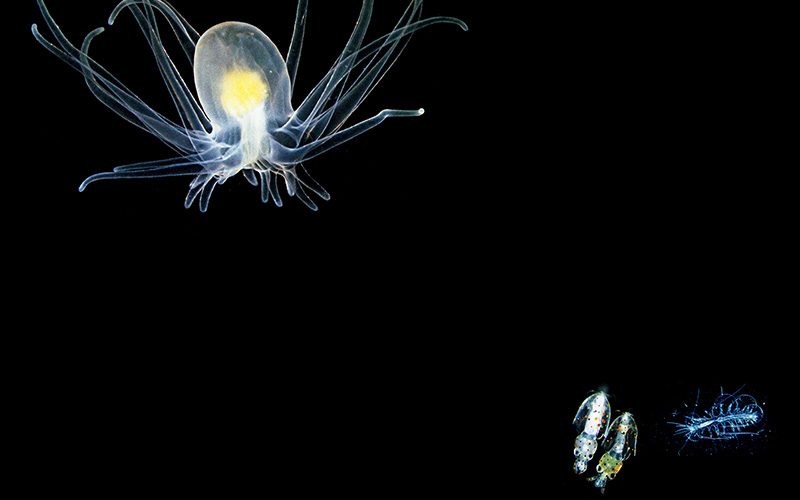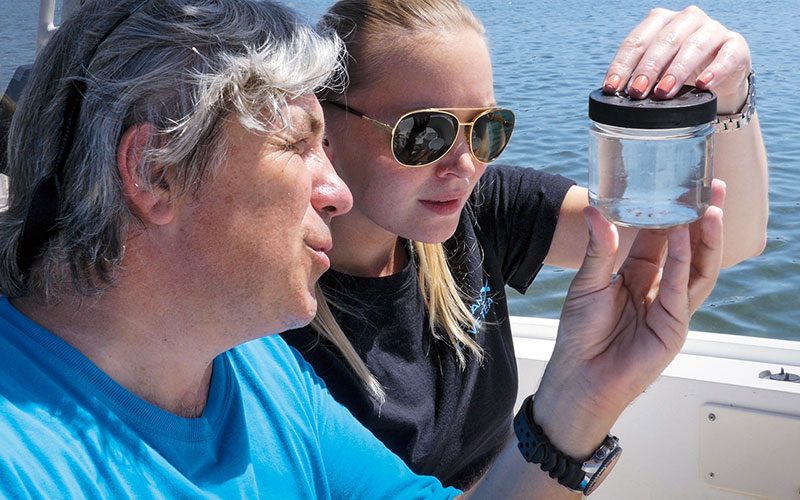What if you could go diving in a drop of water? Do you think there would be nothing to see? Think again.
Our oceans are akin to underwater rainforests; the diversity of organisms we see while diving is part of what makes the sport so popular. But what about the myriad species in our oceans that we don’t see? I’m not talking about sharks that lurk just out of sight off the reef but rather all the microscopic organisms that make up the unique and diverse community of plankton. This microecosystem, in addition to being much more complex and perhaps more dangerous than we would imagine, is crucial for keeping our oceans healthy.
Some people think of plankton as just itty-bitty sea creatures, and some might think of the one-eyed critter named Plankton from SpongeBob SquarePants. Neither association is completely accurate, but neither is completely wrong either. Plankton refers to any living organism in the ocean that cannot move against the current. Most species of plankton are microscopic, but there are some that humans can easily see with the naked eye. Most species of jellyfish, for example, are planktonic. Although plankton can’t swim against current, some are capable of moving vertically in the water column, which helps them avoid predators during the day and feed near the surface at night.
As for SpongeBob’s one-eyed associate, he is actually modeled after a real species of plankton called a copepod, some of which have only a single cyclopean eye. The copepod is one of the most abundant organisms in our oceans. Want to geek out? Grab a plankton net, tow it for five minutes, and examine your findings under a microscope: You are likely to see at least a few one-eyed copepods along with an abundance of other fascinating critters.
Classification
The planktonic world consists of two basic categories: zooplankton and phytoplankton. Zooplankton, or “animal plankton,” must feed on other organisms to gain energy; our copepod friends fall into this category. Phytoplankton are “plant plankton,” which use sunlight to photosynthesize their own source of energy.
There are two different kinds of zooplankton: holoplankton and meroplankton. Holoplankton are eternal drifters — forever dependent upon the currents and never able to leave behind the planktonic world. Meroplankton, however, only spend a portion of their lives as plankton. Many of the more familiar organisms in the ocean, such as crabs, lobsters and fish, begin life as meroplankton and then eventually grow large and strong enough to move against the current.

Life as plankton is not easy. Most species have a short lifespan, many just a few days long. During these brief lives, the plankton have to maximize the amount of time they spend in the photic zone — the top layers of the ocean in which there is enough light for photosynthesis. This can be a tough feat for an organism that cannot swim against a current.
Some plankton cannot swim at all and spend their lives slowly sinking. To compensate, many have evolved to maximize their surface area and/or decrease their density as much as possible. Flattened bodies, appendages, spines and other physical projections have the function of slowing descent. Some plankton link up to form chains with one another, which also slows the rate at which they sink, while others use oil or fat to increase their buoyancy. Air-filled floats also help some marine zooplankton, such as the Portuguese man-o-war, stay afloat.
Another challenge plankton face is being at the bottom of the food chain. Generally speaking, zooplankton feed on phytoplankton, little fish eat zooplankton, big fish eat little fish and so on. Some of the largest animals in the ocean (blue whales, whale sharks and mantas, for example) take a shortcut through the food chain, heading right to the source of maximum energy by filtering the water to feed on plankton. In fact, plankton are a vital food source that support a huge number of animals.
Not To Be Underestimated
Plankton may have a tough life, but sometimes the smallest critters can cause the biggest problems. When environmental conditions are right, phytoplankton can double their rate of reproduction in a phenomenon called an algal bloom. When these algal blooms cause harm to the surrounding ecosystem, this can lead to mass-mortality events in dolphin, seabird and fish populations. Generally, the animals that are higher on the food chain are most affected by toxic blooms because of the process of biomagnification, in which contaminant levels increase in concentration as toxins move up the food chain.
Algal blooms don’t necessarily have to have toxins associated with them to be harmful. Some plankton, such as Chaetoceros spp., have “whiskers” that can tear up fish gills like saw blades. Chaetoceros may be microscopic, but fish are constantly passing water over their gills for oxygen. By passing too many “saw-blade whiskers” over their gills, fish can be killed by masses of phytoplankton. Any algal bloom at the surface affects everything below it by blocking the sunlight that corals and plants need to survive. Furthermore, the decomposition of seagrass, algae and other vegetation will deplete the water of oxygen, thus affecting everything else in the water column.

These algal blooms can have drastic affects on humans as well. People who eat fish from waters experiencing toxic blooms can become ill or even die. You may have heard that eating large barracuda and similar species can be dangerous. This is because of ciguatoxin, which is associated with a planktonic species called Gambierdiscus toxicus that sometimes accumulates in the tissues of larger predators.
If you have ever experienced the effects of a “red tide,” you know first-hand the effects a harmful algal bloom can have on humans. The phytoplankton associated with red tide, Karenia brevis, creates a neurotoxin that can be aerosolized. Not only does red tide close fisheries and lead to massive mortality among fish and mammals, but when red-tide waves crash, the toxin is released into the air, giving beachgoers coughs and itchy throats.
An Essential Piece of the Puzzle
Plankton can certainly cause some trouble, but if populations are kept in check they prove not only beneficial but also necessary to the ecosystems in which they are found. As the base of the marine food web, plankton are a vital element of the marine environment. About 80 percent of recreationally and commercially harvested species (fish, crabs, oysters and shrimp) have a planktonic larval stage, and phytoplankton produce at least half of the oxygen we breathe.
If you are worried about global climate change, you need to be concerned about plankton. Carbon in the atmosphere cycles into our oceans, where it is taken up by phytoplankton during photosynthesis. During this process, the carbon is incorporated into the phytoplankton, similar to the way carbon is stored in trees. Some of the carbon is returned to near-surface waters when the phytoplankton are eaten, but some of the phytoplankton, with the carbon, eventually sinks to the bottom of the sea where the carbon is sequestered. Approximately 10 gigatons of carbon are transferred from the atmosphere to the ocean floor each year. Without phytoplankton, carbon would continuously build up in the atmosphere, increasing the greenhouse gases there.
Phytoplankton blooms are also important to scientists because they can teach us about the changing conditions of the marine environment. They can be used as early indicators of climate changes because they depend on specific conditions for growth and have a high sensitivity to phenomena such as eutrophication and pollution. Scientists studying these blooms use satellite imagery, which can detect phytoplankton blooms because the blooms actually change the color of the ocean surface. From outer space, satellite sensors can distinguish even slight variations in color to which our eyes are not sensitive. Different shades of ocean color indicate varying concentrations of phytoplankton.
In addition to providing an important food source for ocean creatures, helping to stabilize our atmosphere and serving as an early-warning system for changing environmental conditions, plankton are also just plain cool. Have you ever gone kayaking or swimming in a bioluminescent bay? The flickering lights in the water are from a few species of plankton that use internal chemical reactions to emit light.
Why these plankton glow depends on the species. The stroke of a paddle or the kick of a diver’s fin causes a green sparkle in the water when dinoflagellates (a type of phytoplankton) are disturbed and glow as a sort of defense mechanism. Some copepods shoot bioluminescent clouds from their posteriors to distract or temporarily blind predators in dark water. Other plankton may glow to attract mates or catch prey.
The world of plankton is fascinating, and because it is not often seen with the naked eye it is also quite mysterious. If nothing else, this incredible world gives you something to think about the next time you accidentally take a gulp of seawater. What tiny life is swimming around in your belly?
© Alert Diver — Q1 Winter 2015